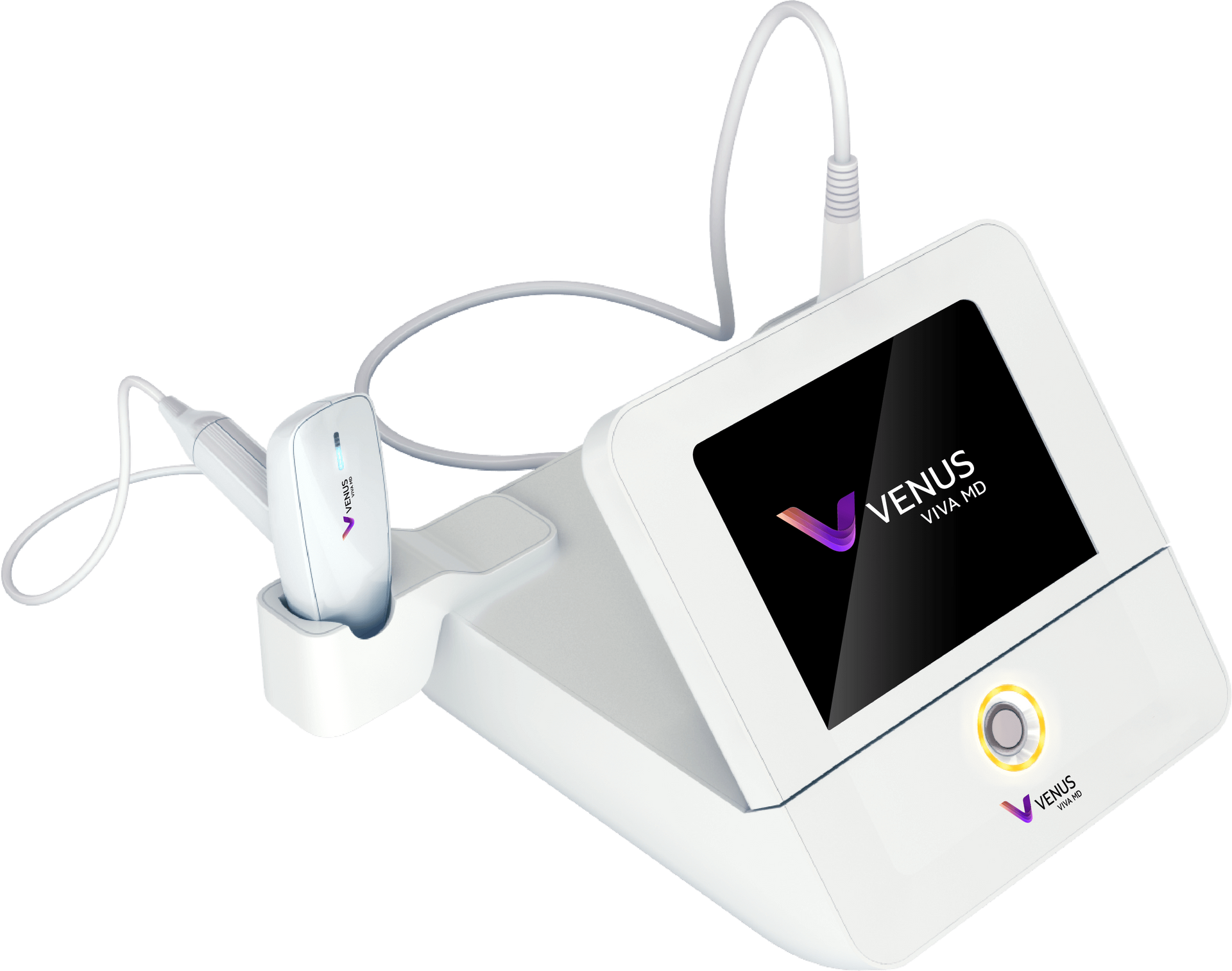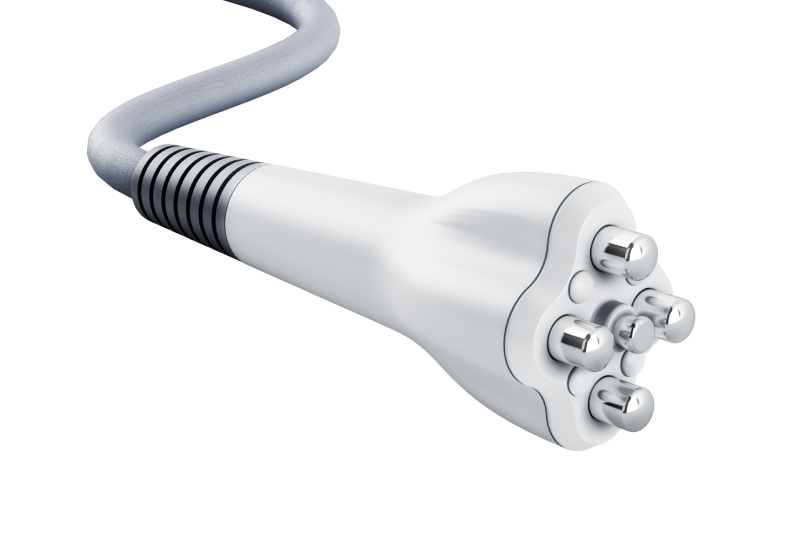-
Body
DEVICESTREATMENTSNon-Invasive Fat LipolysisA non-invasive solution resulting in body fat reductionCellulite ReductionOne of the most common aesthetic concernsCircumferential ReductionBody slimming results without surgery or downtimeSkin TighteningRadio frequency treatmentsEMS Muscle StimulationA non-invasive FlexMAX muscle toning treatment
-
Face & Skin
DEVICESTREATMENTSTriBella™A tri-modality aesthetic facial therapyAcne TreatmentAddress today's most common skin conditionWrinkle ReductionWrinkle reduction solutions for this in-demand treatmentHair RemovalCutting-edge technology to provide long-lasting resultsPhotorejuvenationTreat discolouration and other signs of premature agingSkin ResurfacingRepair signs of skin damage
-
Hair
DEVICESTREATMENTS
- About
-
News & Events
- Education
-
Contact
Venus Viva™ MD
Vv.
NanoFractional Skin Resurfacing for All Skin Types
Venus Viva™ MD is a highly customizable professional skin resurfacing and skin tightening device.

Customizable Skin Resurfacing in a tabletop device
Improve the appearance of textural skin conditions such as scars (including acne scars), rosacea, striae, uneven skin texture, enlarged pores, dyschromia, and pigmentation. Venus Viva™ MD's unique NanoFractional Radio Frequency technology, features state-of-the-art patented tip technology. High-energy density is uniformly distributed through a small footprint per pin (160 x 38 µm2), promoting faster tissue healing while treating all Fitzpatrick skin types I-VI. Full operator control of ablation and coagulation results in very little, to no, downtime compared to other technologies available on the market.


Additional Features
LED Touch Screen
LED Touchscreen enables ease of operator use and enhanced work flow.
INTEGRATED IoT TECHNOLOGY
Latest data collection technology to enhance business operations. Helps treatment providers with optimizing business practices and improving treatment efficiency
DiamondPolar™ Applicator with (MP)2 Technology
Wrinkle reduction
- Unique combination of Multi-Polar Radio Frequency (RF) and Pulsed Electro Magnetic Fields (PEMF)
- With the capabilities of Multi-Polar Radio Frequency applicators, the Venus Viva™ MD uses a complex algorithm to deliver homogeneous energy and volumetric heating to multiple tissue depths, allowing for quick and safe buildup of heat and easy maintenance of therapeutic temperature throughout the treatment
-
MORE
- Effect of Multi-Polar RF is enhanced by PEMF, a non-thermal mechanism emitted through the applicator’s electrodes
- Through synergistic (MP)2, RF heats and directly stimulates fibroblasts, while PEMF is known to promote angiogenesis and induce fibroblast proliferation through release of the growth factor FGF-2, resulting in increased collagen synthesis2
- (MP)2 is therefore effective in collagen remodelling for body contouring via skin tightening, cellulite reduction, and wrinkle reduction, and the creation of new capillaries for renewal of blood supply.
-
MORE
NanoFractional skin resurfacing allows the operator to customize ablation and coagulation settings. Radio frequency energy is delivered into the skin, creating micro-channels surrounded by intact tissue, which promote faster wound healing, little-to-no downtime, and reduces the risk of post-inflammatory hyperpigmentation (PIH).
NanoFractional Radio Frequency
skin resurfacing
with SmartScan™ Technology uses a unique algorithm and pattern selection technology that enables the operator to generate customized patterns for maximum flexibility and patient safety. Two tip options for highly customized treatments
80 pin tip – up to 124 mJ/pin
160 pin tip – up to 62 mJ/pin
The Results Speak for Themselves
All of the before-and-after photos for our aesthetic treatments are from certified Venus providers showcasing real patient results. Images are never edited or altered.
Tech Specs
Technology
-
Device
Input Voltage - 100/120/240V ~, 350W (Max.), 50/60 Hz
Output RF Frequency - 1 MHz, 460 KHz
Fuse - 3.15A, 250V
Max. RF Output Power - Up to 120 watts (Nanofractional RFTM)Up to 60 watts (DiamondPolarTM)
Max. Output Energy NanoFractional RF™ Applicator - 62 mJ/pin
Magnetic Pulse Frequency - 15 Hz
Magnetic Field - 15 Gauss
Dimensions -40 cm x 38 cm x 28 cm / 15.75 in x 14.96 in x 11.02 in (D x W x H)
Weight - 8 kg / 17.6 lb
-
Applicators
DiamondPolar™ Applicator*
Uses proprietary (MP)2 technology, a combination of Multi-Polar Radio Frequency (RF) and Pulsed Electro Magnetic Fields (PEMF), to treat moderate to severe wrinkles and rhytides
Multi-Polar RF uses a complex algorithm to deliver homogeneous energy and volumetric heating to multiple tissue depths, allowing for quick and safe buildup of heat, and easy maintenance of therapeutic temperature throughout the treatment
Effect of Multi-Polar RF is enhanced by PEMF, a non-thermal mechanism emitted through the applicator’s electrodes
Through synergistic (MP)2, RF directly stimulates fibroblasts, while PEMF is known to induce fibroblast proliferation and stimulate new collagen production through release of the growth factor FGF-24
Treatments with this applicator are comfortable with no downtime, and RF technology is proven safe for all skin types
Two tip options for highly customized treatments
80 pin tip – up to 124 mJ/pin
160 pin tip – up to 62 mJ/pin
Uses unique NanoFractional RF™ technology with adjustable ablation and coagulation parameters, to deliver radio frequency energy into the skin, creating micro-channels surrounded by intact tissue
Features SmartScan™ technology for uniform and safe energy delivery to all skin types
Designed to resurface the skin, which helps reduce the appearance of acne scars and other scars, striae, rosacea, dyschromia, deep wrinkles, enlarged pores, and uneven skin texture and pigmentation for all skin types
A published clinical study showed that four weeks after the last treatment, total surface area, length, and width of striae alba significantly decreased from the baseline (p < 0.001). Patient satisfaction scores of “Satisfied” and “Very Satisfied” for changes in texture, size, and overall improvement were 96.67%, 93.94%, and 96.97%, respectively¹
Another peer-reviewed clinical study showed that NanoFractional RF™ is effective in improving skin texture and pigmentation²
NanoFractional RF™

“Venus Viva™, the latest fractional radio frequency device, has demonstrated great results in improvements to photo damaged skin, lines and wrinkles, as well as reduced acne and traumatic scars. This enhanced technology with its large footprint and SmartScan™ feature elevates the playing field in fractional treatments. The Venus Viva™ is a game-changer for clinicians and for patients.”
Michael H. Gold, MD
Speak To An Expert
To book a consultation or a demo, please contact us by clicking the button below and a representative will reach out to you directly.
INDICATIONS FOR USE:
*The Venus Viva™ MD is cleared by the FDA, licensed by Health Canada and has CE Mark for the use in dermatological procedures requiring ablation and resurfacing of the skin using the Viva™/Viva™ MD applicator, and the non-invasive treatment, reduction in the appearance of moderate to severe facial wrinkles and rhytides for females in Fitzpatrick skin types I-IV with the DiamondPolar™ applicator.
REFERENCES:
- Ponqgsrihadulchai N, Chalermchai T, Ophaswongse S, Pongsawat S, Udompataikul M. An efficacy and safety of nanofractional radiofrequency for the treatment of striae alba. J Cosmet Dermatol. 2016; 1-7.
- ↩
- Hongcharu W, Gold M. Expanding the clinical application of fractional radiofrequency treatment: Findings on rhytides, hyperpigmentation, rosacea, and acne redness. J Drugs Dermatol. 2015 Nov; 14(11): 611-17.
- ↩
- Ponqgsrihadulchai N, Chalermchai T, Ophaswongse S, Pongsawat S, Udompataikul M. An efficacy and safety of nanofractional radiofrequency for the treatment of striae alba. J Cosmet Dermatol. 2016; 1-7.
- ↩
- Callaghan, M. J., Chang, E. I., Seiser, N., Aarabi, S., Ghali, S., Kinnucan, E. R., . . . Gurtner, G. C. (2008). Pulsed Electromagnetic Fields Accelerate Normal and Diabetic Wound Healing by Increasing Endogenous FGF-2 Release. Plastic and Reconstructive Surgery, 121(1), 130-141. doi:10.1097/01.prs.0000293761.27219.84
Why Venus
Body Devices
Body Treatments
Face & Skin Devices
Face & Skin Treatments
Hair Restoration Devices
Hair Removal Devices
Legal
For more information call: (888) 907-0115 // info@venusconcept.com // 235 Yorkland Blvd., Suite 900, Toronto, ON, M2J 4Y8 Canada
For more information call: (888) 907-0115 // info@venusconcept.com // 235 Yorkland Blvd., Suite 900, Toronto, ON M2J 4T8 Canada
THIS WEBSITE USES COOKIES TO HELP GIVE YOU THE BEST EXPERIENCE POSSIBLE. BY CONTINUING TO USE THIS SITE, YOU CONSENT TO OUR USE OF THESE COOKIES.






